Nephrolepis is a perennial evergreen fern belonging to the Davalliev family. This plant is very popular among gardeners. Fern has an exotic appearance and rapid growth: in a year it can double the amount of greenery.
A lot of positive signs and superstitions are associated with the cultivation of nephrolepis, the bulk of which boils down to the beneficial effects of fern on its owner. However, most popular beliefs in which fern bloom is mentioned are doubtful, since it is proved that this plant never blooms.
Caring for nephrolepis is very simple and even at home is very easy. Unlike many other indoor plants, nephrolepis is completely non-toxic. Therefore, fern care can be safely entrusted even to children.
Content
Characteristics and species diversity of nephrolepis
The fern root system is well developed. The roots are shortened, superficial. Leaves are collected by a basal rosette. They are attached to the bush with the help of shortened petioles. The shape of the plates is lanceolate, segmented. The edges of the segments can be flat or serrated, depending on the type.
The leaf length reaches 70 cm, the segment - up to 5 cm. The color of the leaves is represented by a bright green color, mainly lime shades. In Variegate nephrolepis, plate colors combine light green and yellow.
In addition to leaves, bare scaly shoots depart from the rhizome. They are used for vegetative propagation of fern.
Green lady
The variety got its name for tenderness and femininity. Representatives of the Green Lady are often called the green fountain or fireworks. Refined vayas fall down like jets. The leaves grow very densely, creating a lush bush.

They are bright green, slightly curled, with pointed tips. Openwork segments. Flowers are grown as ampelous plants. Due to its unpretentiousness to lighting conditions, they can be located in any part of the room.
Exalted
This variety is considered the most common nephrolepis. Moreover, he is the progenitor of the bulk of indoor fern hybrids.
The leaves of the elevated nephrolepis are very long, erect, can rise above the bush or hang from it under its weight with lush arches. Vayas are single-pinned, but contain about fifty segments. The color of the leaf blades is light green.

This variety is considered the most unpretentious, as it is the most resistant to adverse environmental conditions.
Curly
Nephrolepis Curly, or Curly-haired, is a hybrid of the High grade. The fern got its name for the combination of twisted segments and wavy edges on one plate, which create a curly effect. The plant is grown as an ampel.
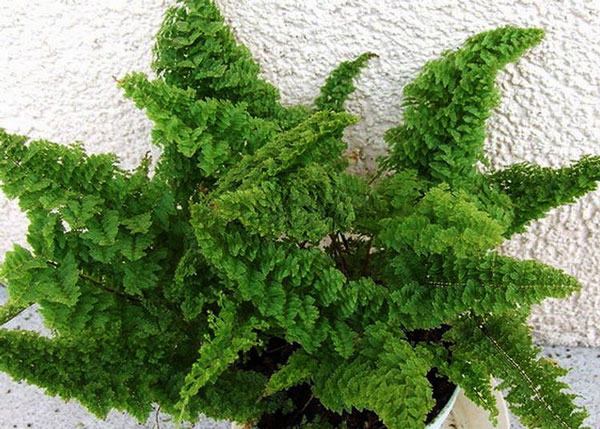
Leaves are lush green, drooping. A curly hybrid has another characteristic difference - it is stunted, so it fits easily even on a cramped shelf.
Sonata
Nephrolepis Sonata is a dwarf fern with small leaves. Representatives of this variety cluster spherically, so they are often grown on window sills or small tables. The leaves have a bright light green color.
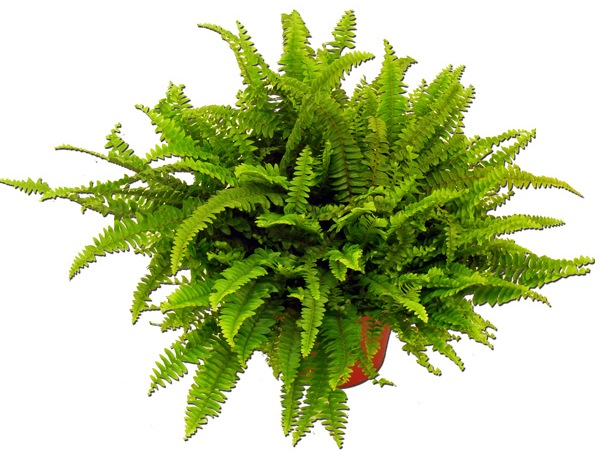
This type of nephrolepis is undemanding in the matter of lighting. It grows well even in the shade.
Brindle
The tiger variety can also be found under the name Nefrolepis Variegatny. It is a compact fern designed for growing in floor pots.
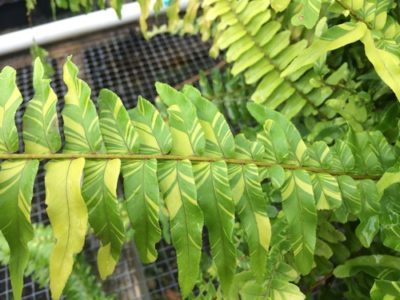
Representatives of the Tiger variety are distinguished by erect vayas, which reach half a meter. The plates are segmented, covered with a marble pattern that combines yellow and light green tones. The pattern resembles a striped tiger.
Care for nephrolepis at home
Caring for nephrolepis is very simple. Growing ferns at home does not cause much trouble to gardeners.
Soil and planting pot
The flower loves light loose soil. It is best to purchase a special substrate for ferns. If this is not possible, you can prepare the soil yourself by mixing in equal proportions such components:
- sheet earth;
- peat;
- sand;
- humus land.
Before planting a fern, a drainage must be prepared. Medium-sized drainage materials, such as expanded clay, pebbles, etc., are well suited for a plant.
When choosing a pot, it should be remembered that nephrolepis is characterized by a superficial root system. The flower will feel comfortable in a shallow but wide pot.
Location and lighting
Since in nature fern grows in forested areas under the shade of trees, the plant is considered shade-loving. Naturally, for normal life, he needs light, and preferably 14-16 hours a day, but the light should be scattered.

Nephrolepis is usually placed on the floor, cabinets or shelves. A windowsill, on which it is permissible to contain a plant, can go to the north side. On the windowsills, whose windows face east, in the morning the flower is shaded with a curtain. The south and west windows are not suitable for growing ferns.
Temperature
The optimal temperature for the period of active growth is considered to be a range from +18 to +21 degrees. If the air temperature in the room is higher, then the flower must be sprayed additionally so that it does not feel discomfort.

At this time, it is recommended that the temperature be gradually reduced to +15 degrees. If this is not possible, the flower continues to be maintained in normal mode with additional spraying. Non-compliance with the temperature regime during dormancy inhibits the development and growth of the plant.
Watering and humidity
All tropical plants like constant moderate humidity and nephrolepis is no exception. In the warm season, it is watered at least 2-3 times a week. If during the period of cold weather the room temperature ranges from +15 to +18 degrees, the plant is watered every week.
For this, the flower pot is placed for some time in a container of water so that the water does not reach the top. This method of irrigation protects against overmoistening of the soil, which has a fatal effect on ferns.
The plant needs systematic spraying. Water for watering and spraying is recommended to be softened. The water temperature should correspond to the room temperature.
Fern requires conditions of high humidity. If the house does not have a special device - an air humidifier, you can put the pot on a tray with wet pebbles or expanded clay.The flower should be kept away from heaters, as they significantly dry the air.
Fertilizers and fertilizing
To accelerate the growth and juiciness of the color of greenery, the plant must be fertilized. Subject to the dormant period, the flower is fed every 2 weeks from March to September, and the rest of the time, feeding is stopped. If the dormant period is not respected, the flower continues to be fertilized in the winter, but the frequency of feeding is reduced by half.
As fertilizers, mineral complexes for decorative leafy plants are used, which can be purchased at a flower shop. Fertilizers should contain a large amount of sodium, aimed at improving the condition of the leaves. Many experts recommend alternating minerals with organic fertilizers.

A high dosage and frequency of fertilizer can cause a burn. Therefore, flower growers are advised to reduce the single dose indicated in the instructions by half, or even four. Feeding is administered only to an adult plant with a fully formed root system.
Pruning
For nephrolepis itself, pruning is not critical. But to maintain its decorativeness, it is necessary. Without pruning, the plant seems groomed and neglected.
Pruning a flower can be of the following nature:
- sanitary;
- cosmetic.
Sanitary pruning involves the removal of dried branches and leaves that are formed during the life of the plant. Also, the release of fern from children during transplantation can be attributed to sanitary pruning. Cosmetic pruning involves removing excess leaves to enhance the decorative value of the flower.
Transfer
Proper transplantation is one of the key points in caring for nephrolepis. The plant tolerates the transplant very poorly. Therefore, even if all the recommendations are followed, the grower may face the fact that after the transplant, the fern may lose several leaves.
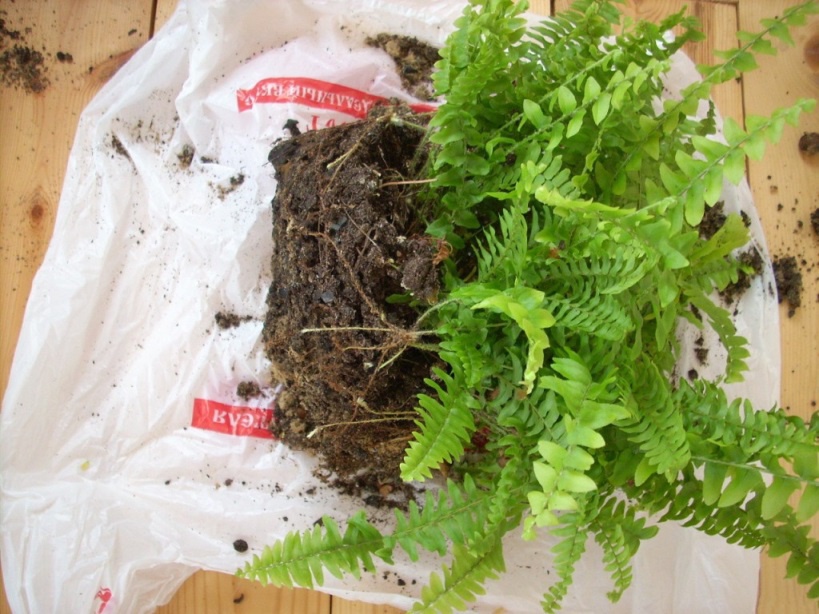
Young nephrolepsis is transplanted annually, and those that have already reached 3 years old - every 3 years. It is very important to expose the roots to the same level as they were in the old pot. Otherwise, there is a high risk of rot in the root system.
Methods of propagation of indoor plants
Nephrolepis propagates in three ways: process mustache, bush division and spores. In indoor floriculture, only the first two methods are popular.
Mustache
Mustaches are special processes that a plant lets out directly from a leaf outlet. Outwardly, they are bare shoots.
Propagation of fern mustache involves such actions:
- An additional pot is placed next to the mother plant, filled with a moist substrate for ferns.
- The mustache is dug into the soil of an additional pot so that its base remains on the mother bush, and the top is in the air.
- For reliability, the mustache is fixed with a bracket or hairpin.
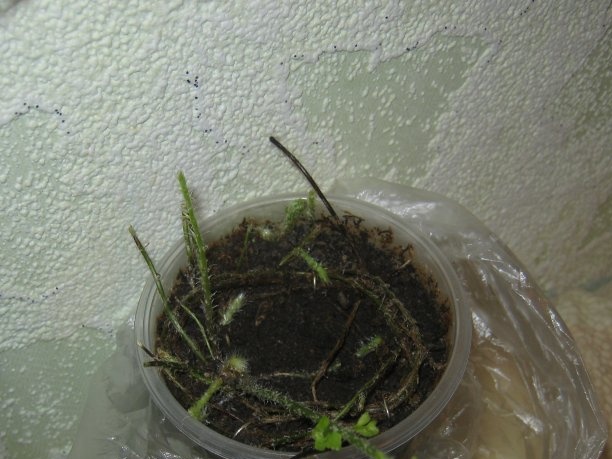
The soil of the additional pot should always be moist. Around the process, air is constantly sprayed, providing a high level of air humidity. When the antennae releases its leaves, it is separated from the mother bush.
Dividing the bush
Adult nephrolepses can be propagated by dividing the bush. In adult plants, over time, several leaf rosettes form. When transplanting from the mother bush, daughter sockets are neatly separated. It is very important that each baby has its own roots and growth point.
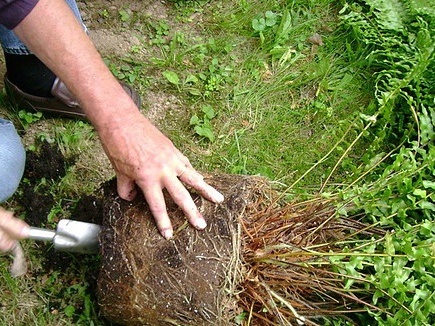
If the roots are very tangled and interfere with division, they should be soaked and untangled. Places of division must be treated with an antiseptic.Pounded activated or charcoal is suitable for this. New ferns are planted as adult plants. They do not need to grow.
Disputes
Reproduction by spores is a very time-consuming, but no less exciting process. Fern spores are located on the inside of the leaf. They are visible to the naked eye. The removal of nephrolepis from spores is as follows:
- Spores are scraped and dried in the sun for two weeks.
- Peat is placed in a glass jar. The layer should be 2-3 cm.
- A jar of peat is placed in the oven for sterilization.
- The peat is moistened, spores are poured on it. The jar is closed with a lid.
- The jar is placed in a warm place with bright light. Spores germinate in high humidity. The spores are aired daily.

After all these procedures, the grower should be patient and wait. After some time, moss will appear on the peat. This is an intermediate stage in the development of nephrolepis. Only after 8-10 weeks will young ferns begin to develop. When they get a little stronger, they are planted separately.
It should be noted that not all indoor fern species can reproduce by spore. Some of them give rise to non-viable disputes.
Why do leaves of nephrolepis dry?
Growing nephrolepis, a grower may encounter certain difficulties. One of the most common problems is the drying out of leaf blades. The leaves can dry for various reasons, but most often this is due to improper hydration and infection of the fern with diseases and pests.
Optimal hydration
Drying of the plates may be due to a lack of moisture. From a small amount of water or rare watering, the leaves dry completely. Sometimes, before drying, plates of fern leaves can change: change the usual color to brown, curl up, wither.
Such transformations indicate a violation not only of the water balance of nephrolepis, but also of the temperature regime of its content. Such changes occur due to irrigation with cold water. If only the tips of the leaves dry, this indicates a low level of humidity around the flower.
Disease and treatment
The most common diseases of nephrolepis are gray and root rot. These diseases are dangerous, but are quite successfully treated in the early stages.
Gray rot, or botritis, is a fungal disease of plants that affects its terrestrial organs. Initially, small brown spots can be seen on the leaves of the fern. Over time, they grow and catch the eye. A fluffy gray coating appears on the spots. Affected leaves begin to dry rapidly.
The reason for the appearance of root rot is waterlogging of the soil. The disease is insidious in that it develops in the root system, so at first it does not appear on the ground organs. Only an experienced florist can suspect something is wrong, paying attention to stunting with a healthy fern. When the rot thoroughly affects the root system, the leaves of the nephrolepis dry out.
It is necessary to treat rot with the help of fungicides. All affected parts of the plant must be removed and destroyed.
Pests and control methods
Pests can settle on the leaves of nephrolepis. Most often, the flower suffers from such insects:
- Shield. It is determined by small brown wax spots that appear on the back of the sheet.

Shield - Spider mite. It is impossible to see the parasite, but you can see its cobweb, which the pest leaves on the surface of the leaf.
- Thrips. a very dangerous insect that leaves holes in the leaves. By these holes the pest is identified.
- Mealybug. From infection with a worm, the leaf plate is folded with a tube. If you expand it, you can see a small whitish worm.
Common Growing Questions
Nefrolepis is an indoor fern that is highly decorative. The plant is very popular among flower growers, since it is very easy and pleasant to take care of it.



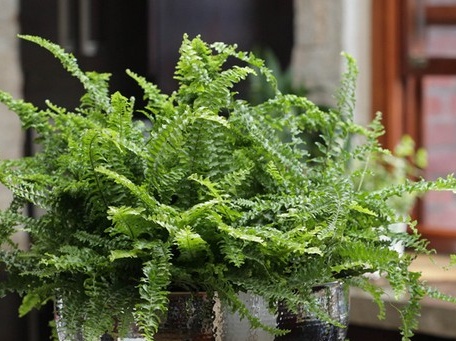



 10 beautiful annuals that bloom all summer
10 beautiful annuals that bloom all summer Sow in the ground, without seedlings: 10 beautiful and unpretentious flowers
Sow in the ground, without seedlings: 10 beautiful and unpretentious flowers Platicodon planting and outdoor care
Platicodon planting and outdoor care Hosta - planting and care in the open ground in the Urals
Hosta - planting and care in the open ground in the Urals